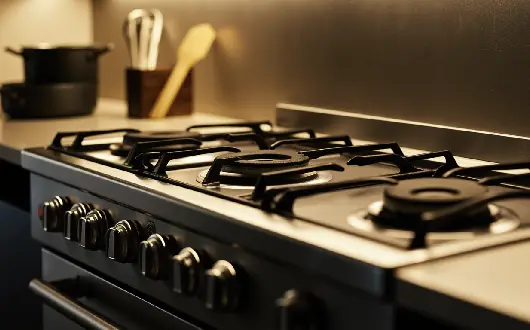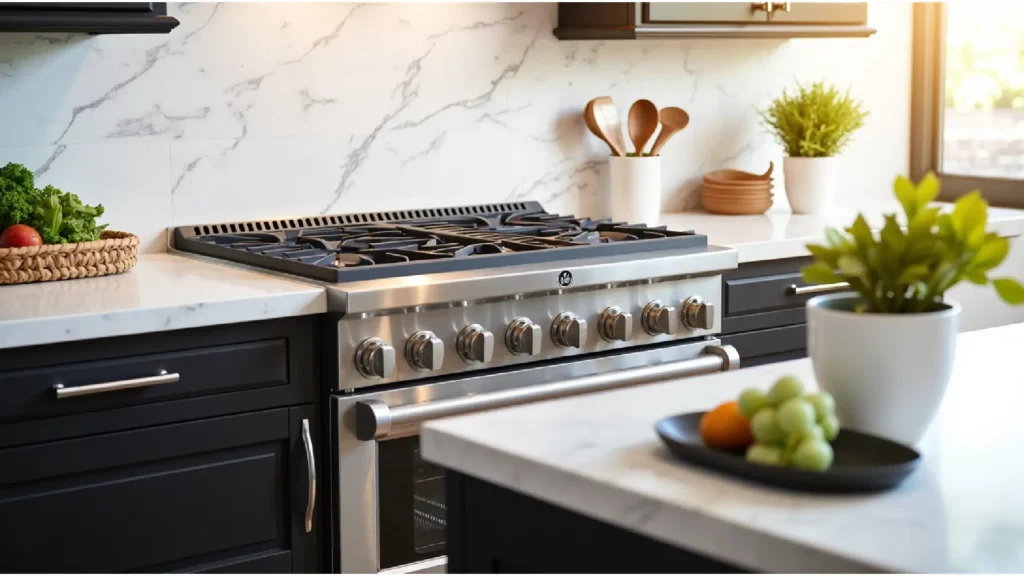
Efficient Ventilation: Gas Cooktop with Downdraft 30
When you think about your kitchen, what comes to mind? Cooking up delicious meals, maybe? But have you ever considered how important it is to have good ventilation while you’re whipping up those culinary masterpieces?
Efficient ventilation in the kitchen isn’t just a luxury; it’s a necessity. It helps remove smoke, steam, and odors that can linger long after you’ve finished cooking. Plus, it keeps the air fresh and breathable, which is especially important if you’re spending a lot of time in there.
To be honest, I used to underestimate the importance of ventilation. I thought opening a window or turning on a fan would do the trick. But once I started using a proper ventilation system, I realized how much of a difference it made.
No more lingering smells of last night’s dinner or that annoying haze that settles over everything. Good ventilation can also help prevent moisture buildup, which can lead to mold and mildew. So, if you want to keep your kitchen healthy and pleasant, investing in efficient ventilation is definitely the way to go.
Key Takeaways
- Efficient ventilation in the kitchen is crucial for maintaining air quality and removing cooking odors and pollutants.
- A gas cooktop with downdraft 30 offers the advantage of a built-in ventilation system that eliminates the need for a separate hood, saving space and providing a sleek look.
- Downdraft ventilation works by drawing cooking fumes and odors downward and expelling them outside, or filtering and recirculating the air back into the kitchen.
- Proper installation and regular maintenance of a gas cooktop with downdraft 30 are essential for ensuring its optimal performance and longevity.
- When choosing a gas cooktop with downdraft 30, factors to consider include the size and layout of the kitchen, the cooking habits of the user, and the available ventilation options.
Advantages of a Gas Cooktop with Downdraft 30
Combining Cooking and Ventilation in One
If you’re in the market for a new cooktop, consider a gas cooktop with downdraft ventilation. This innovative design combines cooking and ventilation in one package, eliminating the need for bulky hoods that can cramp your style or make your kitchen feel smaller. Instead, the downdraft system pulls smoke and odors down and out of your kitchen without taking up extra space.
The Benefits of Gas Cooktops
Gas cooktops are often preferred by home chefs because they provide instant heat and precise temperature control. When you combine this with a downdraft system, you get the best of both worlds. You can sauté, boil, or simmer while knowing that any unwanted smoke or steam is being efficiently whisked away.
Aesthetics Matter Too
Plus, gas cooktops with downdraft ventilation often come with designs that can really elevate the look of your kitchen. So, if aesthetics matter to you as much as functionality, a gas cooktop with downdraft might just be your perfect match.
How Downdraft Ventilation Works
So, how does this downdraft ventilation actually work? It’s pretty fascinating when you break it down. Essentially, the system is built into the cooktop itself.
When you turn on the cooktop and start cooking, the downdraft fan activates and pulls air down through vents located at the back of the cooktop. This air is then filtered and expelled outside or recirculated back into the kitchen after being cleaned. One thing to keep in mind is that downdraft systems are designed to work best when you’re cooking on high heat.
If you’re simmering something on low, you might not notice as much airflow. But when you crank up the heat for frying or boiling, that’s when you really see the benefits. It’s like having a personal assistant in the kitchen who’s always ready to help keep things fresh and clean while you focus on your cooking.
Installation and Maintenance of a Gas Cooktop with Downdraft 30
| Aspect | Details |
|---|---|
| Installation Time | Approximately 2-3 hours |
| Maintenance Frequency | Every 6 months |
| Cleaning Method | Use mild soap and water for the cooktop surface, and remove and clean the downdraft filter regularly |
| Replacement Parts Cost | Filter replacement cost: 20-40 |
| Professional Service Cost | Average service cost: 100-200 |
Now, let’s get into the nitty-gritty of installation and maintenance. Installing a gas cooktop with downdraft isn’t exactly a DIY project unless you’re super handy with plumbing and electrical work. It usually requires professional installation to ensure everything is set up safely and correctly.
You’ll need to make sure there’s proper ventilation access to the outside or a recirculation option if that’s what you prefer. Once it’s installed, maintenance is relatively straightforward but still important. Regularly cleaning the filters is key to keeping your downdraft system working efficiently.
Depending on how often you cook, you might need to clean or replace them every few months. It’s also a good idea to wipe down the cooktop itself after each use to prevent grease buildup. Trust me; it’s way easier to keep things clean than to deal with a big mess later on.
Factors to Consider When Choosing a Gas Cooktop with Downdraft 30
When you’re shopping for a gas cooktop with downdraft, there are several factors to consider. First off, think about the size of your kitchen and how much cooking space you actually need. If you’re someone who loves hosting dinner parties or cooking elaborate meals, you might want a larger model with multiple burners.
On the flip side, if you’re working with limited space, there are compact options that still pack a punch. Another thing to keep in mind is the power of the burners. Some models come with high-BTU burners that can heat up quickly and efficiently, which is great for searing meats or boiling water fast.
Also, consider the design and finish of the cooktop—do you want stainless steel for that modern look or something else that matches your kitchen decor? And don’t forget about budget! Prices can vary widely based on features and brand reputation, so it’s worth doing some research before making a decision.
Comparing Gas Cooktop with Downdraft 30 to Other Ventilation Options

Comparing Downdraft to Traditional Range Hoods
Traditional range hoods are probably the most common alternative, but they can be bulky and take up valuable overhead space in your kitchen. Plus, they often require ductwork that can complicate installation if your kitchen layout isn’t ideal.
The Quiet Advantage of Downdraft
On top of that, downdraft systems tend to be quieter than traditional hoods since they’re built into the cooktop itself rather than hanging above it.
Weighing the Power of Downdraft Ventilation
However, one downside is that they may not be as powerful as some high-end range hoods when it comes to removing smoke and odors quickly. So if you’re an avid fryer or love cooking with strong spices, you might want to weigh your options carefully before making a choice.
Tips for Using a Gas Cooktop with Downdraft 30
https://www.youtube.com/embed/c8jb-t4fESI
Once you’ve got your gas cooktop with downdraft set up, you’ll want to make sure you’re using it effectively. One tip I’ve found helpful is to always turn on the downdraft fan before you start cooking—this way, it’s already working to pull away any smoke or steam right from the get-go. Also, try to position pots and pans so that they’re directly over the downdraft vents for maximum efficiency.
Another thing to consider is using lids when possible. Covering pots while boiling or simmering can help reduce steam and odors escaping into your kitchen air. And don’t forget about experimenting with different burner settings!
Sometimes lower heat can work just as well for certain dishes without creating too much smoke or mess.
The Benefits of Investing in Efficient Ventilation
In conclusion, investing in efficient ventilation for your kitchen—especially through a gas cooktop with downdraft—can really enhance your cooking experience. Not only does it keep your kitchen air fresh and clean, but it also adds a modern touch to your space without sacrificing functionality. You’ll find yourself enjoying cooking more when you don’t have to deal with lingering odors or excess moisture.
So if you’re thinking about upgrading your kitchen appliances, consider going for that gas cooktop with downdraft option. It’s an investment that pays off in comfort and style while making your cooking adventures more enjoyable. After all, who wouldn’t want a kitchen that looks great and feels even better?
If you are considering purchasing a gas cooktop with downdraft 30, you may also be interested in reading about the benefits of a Wolf 30 gas cooktop. This article highlights the high-quality construction and performance of Wolf gas cooktops, which are known for their durability and precision cooking capabilities. Investing in a Wolf gas cooktop may be a great choice for those looking for a reliable and efficient cooking appliance.
FAQs
What is a gas cooktop with downdraft 30?
A gas cooktop with downdraft 30 is a cooking appliance that combines a gas cooktop with a built-in downdraft ventilation system. This allows for efficient removal of cooking odors, smoke, and grease directly from the cooking surface.
How does a gas cooktop with downdraft 30 work?
The gas cooktop provides the cooking surface for preparing meals, while the downdraft ventilation system pulls cooking by-products downward and away from the cooktop. This helps to keep the kitchen air clean and free of odors.
What are the benefits of a gas cooktop with downdraft 30?
Some benefits of a gas cooktop with downdraft 30 include efficient ventilation, space-saving design, and the ability to eliminate the need for a separate range hood. It also provides a sleek and integrated look in the kitchen.
What are some considerations when choosing a gas cooktop with downdraft 30?
When choosing a gas cooktop with downdraft 30, it’s important to consider the size and layout of your kitchen, the power and efficiency of the ventilation system, and the overall quality and features of the cooktop itself. Additionally, installation requirements and compatibility with existing kitchen setups should be taken into account.
Are there any maintenance requirements for a gas cooktop with downdraft 30?
Regular maintenance of a gas cooktop with downdraft 30 typically includes cleaning the cooktop surface, as well as periodic cleaning and replacement of the downdraft ventilation filters. It’s important to follow the manufacturer’s guidelines for proper care and maintenance.



